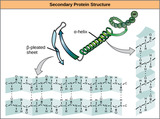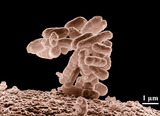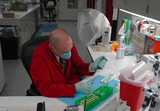
- Subject:
- Applied Science
- Biology
- Life Science
- Material Type:
- Module
- Date Added:
- 07/10/2017


By the end of this section, you will be able to:Describe the four major types of lipidsExplain the role of fats in storing energyDifferentiate between saturated and unsaturated fatty acidsDescribe phospholipids and their role in cellsDefine the basic structure of a steroid and some functions of steroidsExplain the how cholesterol helps to maintain the fluid nature of the plasma membrane

By the end of this section, you will be able to:Describe the four major types of lipidsExplain the role of fats in storing energyDifferentiate between saturated and unsaturated fatty acidsDescribe phospholipids and their role in cellsDefine the basic structure of a steroid and some functions of steroidsExplain the how cholesterol helps to maintain the fluid nature of the plasma membrane

By the end of this section, you will be able to:Describe the structure of nucleic acids and define the two types of nucleic acidsExplain the structure and role of DNAExplain the structure and roles of RNA

By the end of this section, you will be able to:Describe the functions proteins perform in the cell and in tissuesDiscuss the relationship between amino acids and proteinsExplain the four levels of protein organizationDescribe the ways in which protein shape and function are linked

By the end of this section, you will be able to:Understand the synthesis of macromoleculesExplain dehydration (or condensation) and hydrolysis reactions

By the end of this section, you will be able to:Understand the synthesis of macromoleculesExplain dehydration (or condensation) and hydrolysis reactions

By the end of this section, you will be able to:Define matter and elementsDescribe the interrelationship between protons, neutrons, and electronsCompare the ways in which electrons can be donated or shared between atomsExplain the ways in which naturally occurring elements combine to create molecules, cells, tissues, organ systems, and organisms

By the end of this section, you will be able to:Define matter and elementsDescribe the interrelationship between protons, neutrons, and electronsCompare the ways in which electrons can be donated or shared between atomsExplain the ways in which naturally occurring elements combine to create molecules, cells, tissues, organ systems, and organisms

By the end of this section, you will be able to:Explain why carbon is important for lifeDescribe the role of functional groups in biological molecules

By the end of this section, you will be able to:Explain why carbon is important for lifeDescribe the role of functional groups in biological molecules


By the end of this section, you will be able to:Describe the properties of water that are critical to maintaining lifeExplain why water is an excellent solventProvide examples of water’s cohesive and adhesive propertiesDiscuss the role of acids, bases, and buffers in homeostasis

By the end of this section, you will be able to:Describe the properties of water that are critical to maintaining lifeExplain why water is an excellent solventProvide examples of water’s cohesive and adhesive propertiesDiscuss the role of acids, bases, and buffers in homeostasis


By the end of this section, you will be able to:Identify the shared characteristics of the natural sciencesSummarize the steps of the scientific methodCompare inductive reasoning with deductive reasoningDescribe the goals of basic science and applied science

By the end of this section, you will be able to:Identify the shared characteristics of the natural sciencesSummarize the steps of the scientific methodCompare inductive reasoning with deductive reasoningDescribe the goals of basic science and applied science

By the end of this section, you will be able to:Identify and describe the properties of lifeDescribe the levels of organization among living thingsRecognize and interpret a phylogenetic treeList examples of different sub disciplines in biology

By the end of this section, you will be able to:Identify and describe the properties of lifeDescribe the levels of organization among living thingsRecognize and interpret a phylogenetic treeList examples of different sub disciplines in biology
